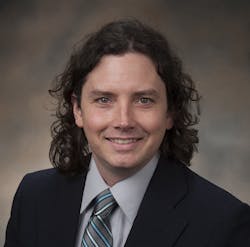Education helps engineers stand out
When you ask an engineer about their education, some may think back to countless hours of differential equations, lectures, and chemistry labs.
Others may have a more cheerful recollection about a senior project or graduate thesis subject. Whatever answers come to mind, it quickly becomes obvious that there is no shortage of education in an engineer’s background.
Engineers go through extensive formal education, and many continue on to advanced degrees throughout their careers. To practice, engineers must be licensed in their state, and in order to be licensed must earn a degree from an accredited university, work under a Professional Engineer for four years, and, finally, pass the Principles and Practice of Engineering exam, also known as the Professional Engineer (PE) exam.
Outside of formal education, engineers may turn to internships for hands-on education. Internships and co-ops can be an excellent path to securing a job after graduation.
The first job an engineering graduate takes out of college often plays a significant role in their career, because it is likely where they will begin training for the PE exam. Engineers must meet strict guidelines to even qualify to take this exam—in addition to the four years of work required under a PE, they must complete an extensive application process.
When an engineer is starting out, the PE they train under often becomes a mentor. That PE, who is often mid-level in their own career, works directly with the new engineer to provide training, answer questions, review their work, and offer feedback. The PE can also ensure that engineers applying for their own PE license meet their particular state’s requirements. For example, I have seen engineers—particularly those who focus on bridge inspections—run into issues with their PE exam application, because they needed to focus their application more on their design experience.
Even after an engineer takes their PE exam, their education continues. Today, most states require regular professional development hours to maintain a PE license. Seminars, webinars, training courses, conferences, and symposia all typically earn an engineer credit towards education. Credit is also available through online third parties in a pinch, although it can be difficult to find courses that are applicable to an engineer’s specific job.
Before the COVID-19 pandemic, many engineers attended in-person conferences to earn credits. But with education and training harder to come by in person, the industry has seen companies step up to offer more virtual training to staff.
At Modjeski and Masters, I lead a webinar series that enables our team can continue to earn professional development hours with monthly trainings. Sometimes the sessions are employee-led and cover a recent project. Other sessions are with external speakers who cover technical subjects, such as how to use a particular software for some aspect of bridge design.
Mentoring is another aspect of education that continues beyond someone’s first few years in the field. An engineer’s work must always be peer reviewed and checked for errors, providing ample opportunity for feedback.
Some companies also offer formal mentoring throughout someone’s career. At Modjeski and Masters, we have a protégé-led mentoring program that our staff can apply for. Employees can apply to the program and are then paired up with a chosen mentor. We have employees of all experience levels apply for the program each year. The company then provides time for mentoring sessions during the workday, and the mentor helps assign learning goals to work towards. Beyond mentoring, programs like this one allow engineers to foster professional relationships and help facilitate self-improvement and overall career growth.
Perhaps unsurprisingly, education is an area that engineers can feel proud and maybe even a little protective of, because this background is what gives us our professional identity as we start on our respective journeys.
Without a doubt, engineers learn vast amounts of information as we progress through our endeavors. That pride should continue to build in each new skill that we learn, making us better engineers and preparing us to better serve the public.
